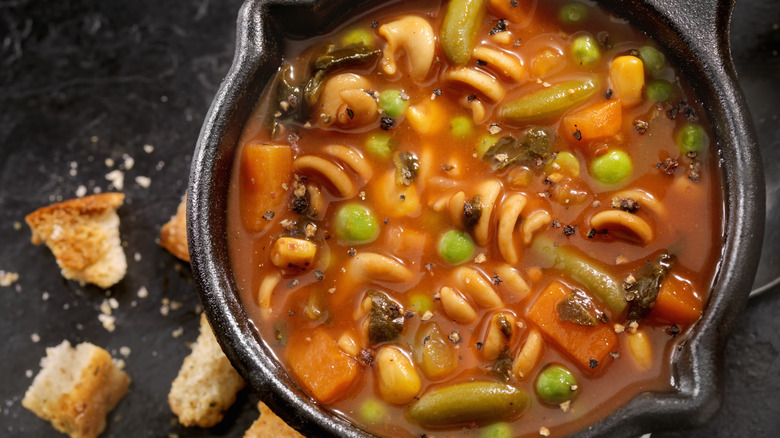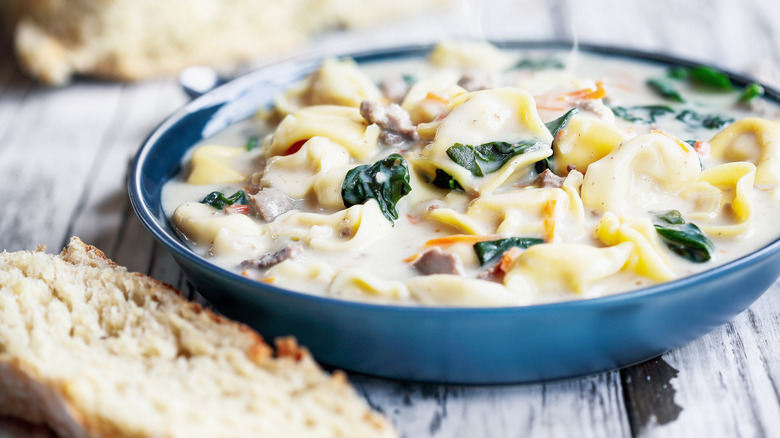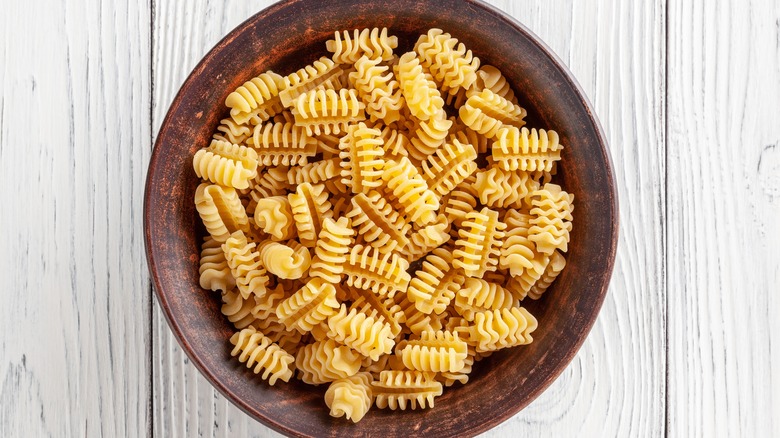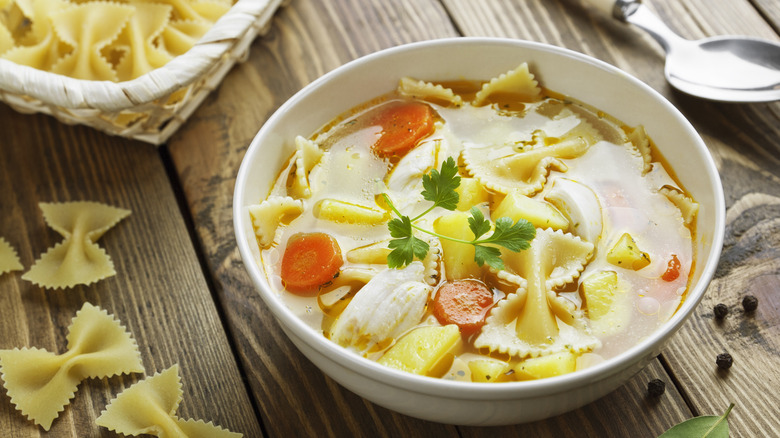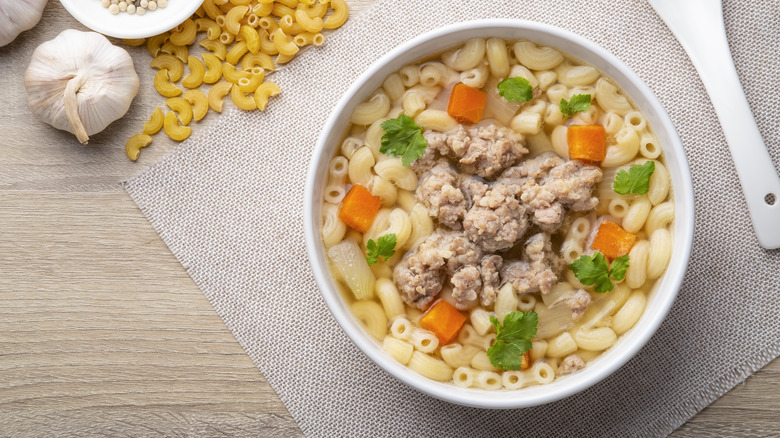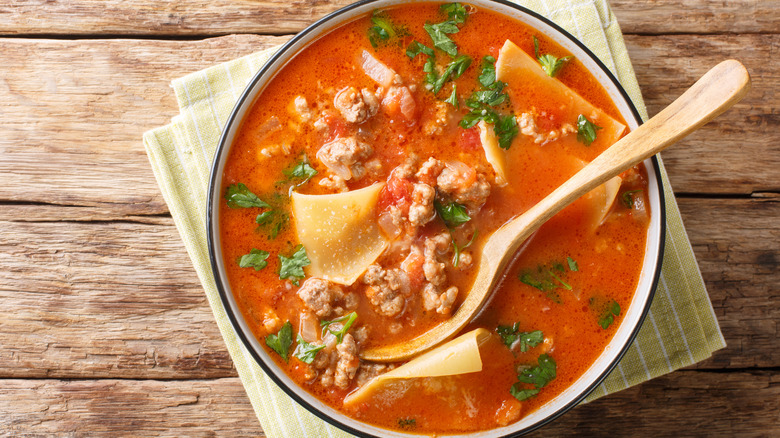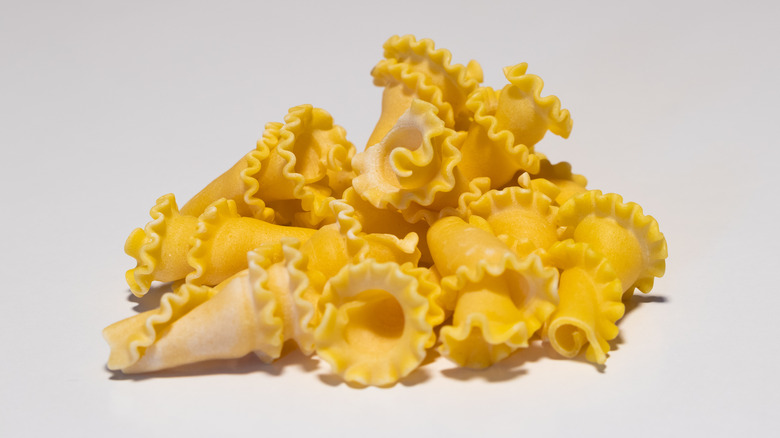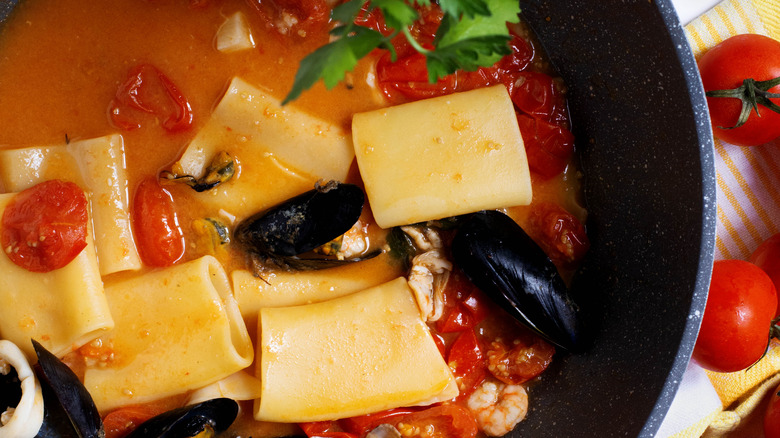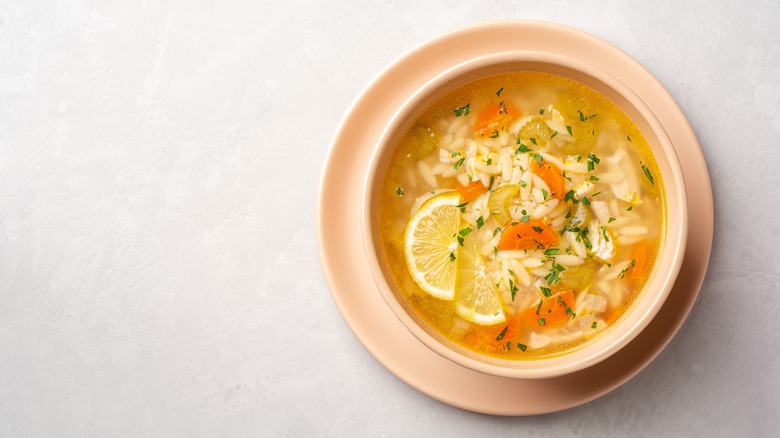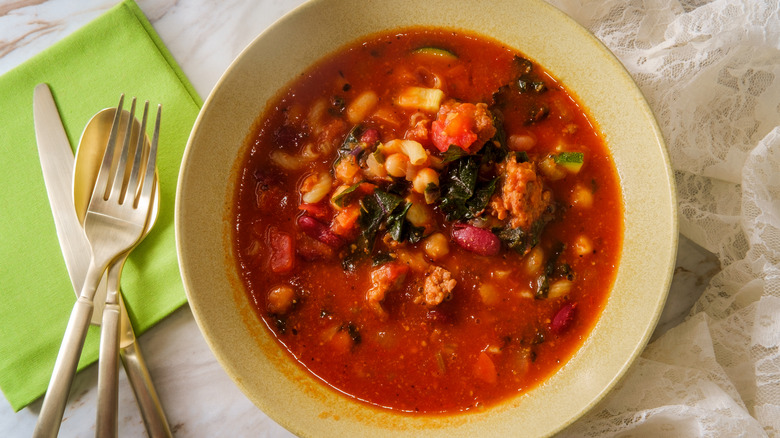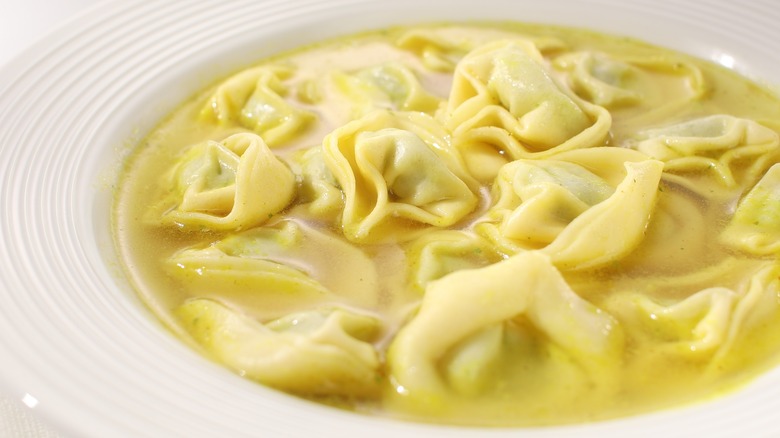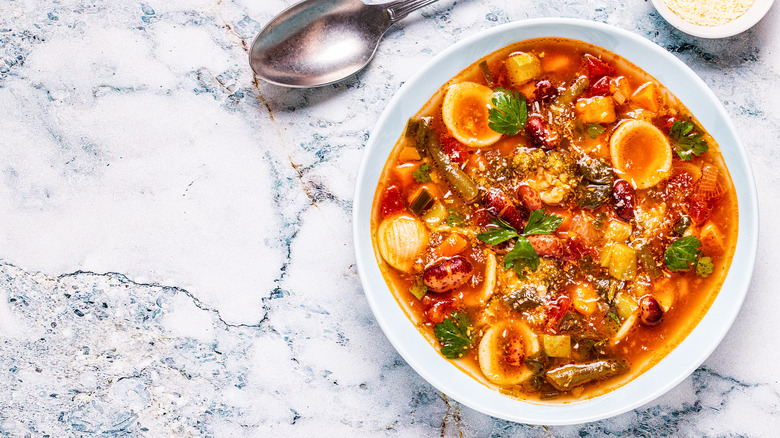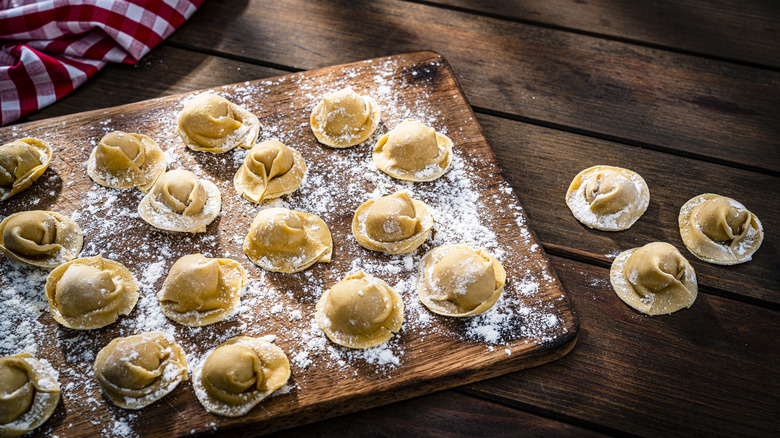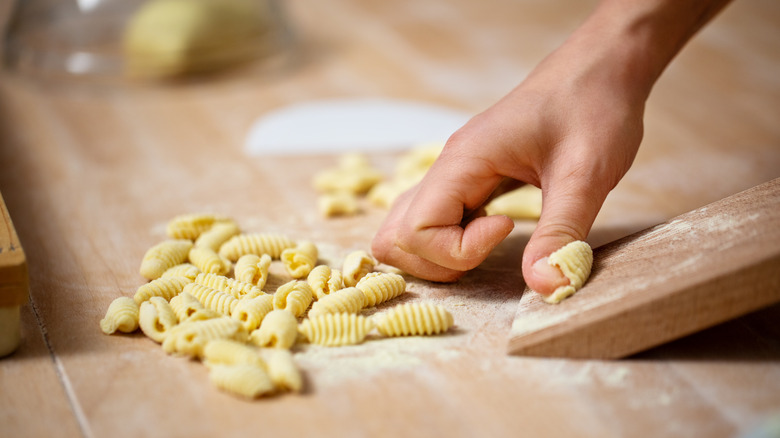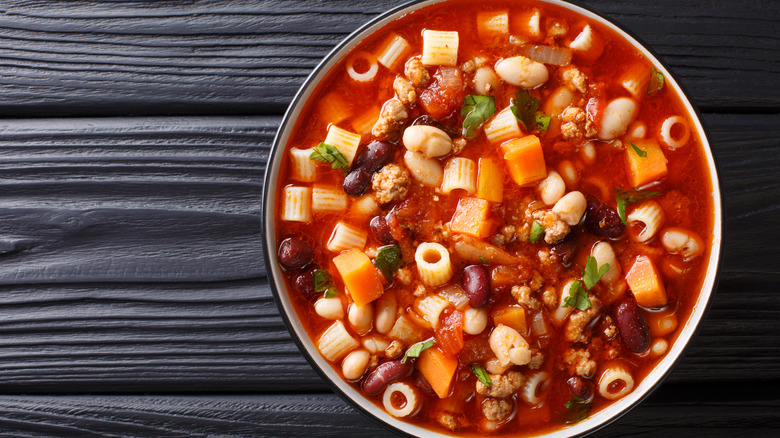14 Best Pasta Shapes To Use In Homemade Soup
When it comes to pasta, there's so much that creative home cooks can do. Yes, a bowl of noodles with sauce is classic, and the variations are endless, but have you ever considered adding pasta to your soup? There's no doubt you've tried a basic chicken noodle soup in the past, but we believe pasta has a place in more than just brothy chicken water. Instantly enhance any soup by adding pasta — with one catch. It's important to consider which type of pasta you are going to use. Believe it or not, this decision can make or break your recipe, so we've laid out all of the best pasta shapes to use in homemade soup to steer you in the right direction.
Unless you're enjoying your soup with chopsticks, long stringy noodles can be tough to capture on your spoon. If you're not a chopsticks using pro, opting for a bite-sized noodle shape might make the dining process more enjoyable. Furthermore, you'll want to select a noddle with enough bulk, so that it won't overcook as it sits in the hot broth, and so that it also remains chewy even when reheated. If you have a nice thick or cream-based broth, it makes sense to use a textured noodle so that flavor can get cozy in all of those nooks and crannies, while thinner broth soups do well with slicker noodles and even stuffed pasta. Time to grab your favorite soup recipes, and let's get cooking.
Tortellini
When choosing pasta shapes to use in homemade soup, it's easy to default to a spoon-sized noodle to complement the surrounding proteins and vegetables. However, who says that the pasta can't be the main event? If you want your pasta to be a stand-out aspect of the dish, then opt for a stuffed noodle like tortellini. These little folded pockets can contain anything from meat to cheese, and to vegetables and fresh herbs. Tortellini holds up well in both broth and cream-based soups but tends to steal the show, so be sure that you're pairing the anterior ingredients properly with the stuffing inside of your noodles.
A classic to start with is a basic chicken and tortellini vegetable soup recipe. This particular recipe is made with a white wine and cream base and contains a variety of vegetables including zucchini, onion, garlic, and mushrooms. Because of the cream base and protein pairing, cheese tortellini are cooked right into the broth, absorbing those natural flavors. This version is creamy, decadent, and delicious. However, tortellini can also be used in a broth base when stuffed with either cheese or meat. If you're using a cheese-based pasta, consider using Parmesan rind in the broth to help distribute the umami flavors, and balance the overall mouthfeel.
Radiatori
When searching for a bite-sized pasta that's full of crevices for all of those good flavors to get trapped, look no further than radiatori. Automotive enthusiasts hold onto your seatbelts. The untold truth of radiatori pasta is that it actually gets its name because it resembles a car radiator. That's right, this noodle was modeled after a car part. For those of us who struggle to pump our own gas and can't even begin to understand what that entails, the shape resembles a half-tube with small flat sections attached to the outside. From a distance, it looks almost like corkscrew pasta, cut in half with a curved and empty center.
Besides its unique origins, this pasta does a great job of carrying flavor. We recommend serving it with a broth-based sauce, so its visual complexity can be appreciated. However, the noodles do a great job of holding onto thicker broths between all of their layers, so it is quite versatile. In the end, you won't want to pass on this modern pasta shape, especially when having car enthusiasts over for dinner. Use it in your soup, and see if anyone notices or can identify the shape.
Farfalle
You may know farfalle as bowtie pasta. This is because the little flat rectangles are bunched at the center so the noodles resemble small bowties. Fancy, huh? Farfalle is often found in creamy pasta dishes, and pasta salads, and has been deemed the best pasta to pair with vodka sauce. For those of you who have tangled with farfalle in the past, you know this bite-sized noodle is both fun to eat and to look at.
Soups can be monotonous in appearance, so it's important to add a little flair where you can. Farfalle will not only help your soup pop aesthetically but can also help to stand out against smaller ingredients. Try using farfalle in chicken noodle soup with small chopped vegetables like diced carrots and celery. Alternatively, consider using these little bowties to balance other larger bite-sized ingredients like cuts of beef or sliced carrots in a stew, for instance. Be sure to add your raw pasta into the broth, rather than cook it separately. This will help your farfalle to absorb extra flavor from the soup and not overcook. In the end, you'll be able to enjoy a fun, jazzy-shaped pasta that can help add a little flair of personality to your soup.
Macaroni
We are no strangers to the wonders of macaroni, and we can probably assume the same goes for you. The pairing of macaroni and cheese is so perfect because those little elbow-shaped hollow noodles fill up with cheese sauce and don't seem to want to let go. This means you're indulging in liquid cheese-stuffed noodles, and what sounds better than that? Well, macaroni acts similarly when it comes to soup.
Use these bite-sized noodles to hold your soup broth. We recommend using a cream-based soup so that the macaroni can couple up with its favorite sidekick and kick in our nostalgia for our favorite childhood dish. However, they can also make a great addition to a broth-based minestrone. Unlike many of the other options, you can fit multiple noodles per spoon. Try to match the size of your anterior ingredients to the size of the macaroni to create balance in the soup.
Lasagna
You'd have to live under a rock if you've never heard of lasagna. And we'd be surprised if you disliked the classic pasta casserole dish. Perhaps this is why there are so many variations on the dish, like single-serve only-edges lasagna, deep-fried lasagna, and, of course, lasagna soup. And while we think of the word lasagna as describing that cheesy, tomato-filled bake, it actually describes the noodle itself used in the dish you're picturing. Those long, flat, thin noodles with wavy edging can be used in much more than just casserole dishes, and we think they make the perfect noodle for soup.
While lasagna noodles can be added to almost any creamy soup, we think they work best in a deconstructed lasagna soup that shares many similar ingredients with the classic pasta bake. And while you can go ahead and gather your lasagna dish ingredients like tomatoes, olive oil, garlic, sausage, and cheese, the assembly couldn't be more different. Cook your meats and vegetables, and simmer your tomatoes until sweet before adding broth. Cook your noodles directly in the broth, and if you wish to do so, add a splash of cream or cashew cream. Dollop your ricotta cheese on top of the soup as a garnish, and be sure to reserve some fresh basil and oregano to help brighten your bowl.
Campanelle
When it comes to an organically shaped, artsy noodle, we'd have to place campanelle at the very top. These sturdy little noodles are shaped like flowers, in fact, their name means "bellflower." To make these, the dough is flattened and rolled into a spiral. The edges that show are textured and wavy like flower petals. They are delicate in style but rather chewy and sturdy. Luckily, they fit perfectly on a spoon, which makes them an ideal candidate for soup.
If you're throwing together a springtime soup, complete with colorful vegetables, a light broth, and beautiful garnishes like pea shoots, sliced radishes, and fresh flowers, then it's essential that you match the soup's energy by using campanelle pasta. It's refined, sophisticated, and holds up well in a hot soup. It can even stand out in a recipe with lots of competing factors like bright colors and varying shapes. Consider using campanelle noodles in a broth-based, or lighter soup so that the noodles can show off their beautiful appearance. However, even in a heavy cream broth, they might be a fun surprise as they rise to the surface.
Calamarata
Calamarata pasta is just what it sounds like, pasta in the shape and size of calamari rings. For those of you who don't indulge in the chewy squid dish often, they resemble thick rings about one inch in diameter. However, there is a smaller version called calamaretti. Because of its large, sleek shape, pasta sauce doesn't stick particularly well to calamarata pasta, which makes it the perfect candidate for soup.
Because it was developed in a coastal community, the noodle often goes paired with seafood, although serving it with calamari itself might be off-putting as the two are almost visually indistinguishable but carry very different flavors and textures. Consider adding calamarata pasta to your broth-based or tomato broth-based seafood soup dishes alongside fish, mollusks, crustaceans, and shellfish. Use light flavors like white wine, lemon juice, fresh herbs, and seafood stock to help the broth pop. Don't overcrowd your soup with noodles, as calamarata are rather large and are better off as a feature of the dish instead of the main event, especially because seafood is such a tender and subtle delicacy.
Orzo
Can't decide between adding rice or pasta to your soup? Compromise and spring for a box of orzo pasta. Orzo is made up of small, flat, noodles that resemble large grains of rice. They are the perfect addition to any soup you're trying to bulk up, and like rice, many orzo noodles can fit on a single spoon, helping to surround any additional ingredients. Orzo is typically used in broth-based soups and can be a substitute for rice in any soup.
For orzo newbies, try making a classic chicken noodle or chickpea orzo soup recipe. While rice can be a bit mealy and empty, orzo is much denser and has a chewier, doughy mouthfeel. Add your orzo pasta right into any soup as it finishes cooking in order to allow it to cook right in the broth. Keep in mind that like rice and pasta, it will soak up a great deal of the liquid, so plan accordingly. This little trick can come in handy if you've accidentally added too much broth to your soup and need to thicken it up. Just be sure to give any gluten-intolerant folk in your crowd a heads up that you've used pasta, instead of rice, as it could easily be mistaken for the gluten-free grain.
Cavatappi
Although you may have never heard the word cavatappi before, you've most likely indulged in it a time or two. It's also known as corkscrew pasta and looks quite a bit like hollow corkscrews, or macaroni noodles that are stuck together. It's often found in pasta salads, or macaroni and cheese variations, but makes an incredible pasta shape to use in homemade soup.
While you may have considered macaroni noodles for your soup, you may find that they are just too small for your liking. If that's the case, then look no further than their longer, twirlier cousin, cavatappi. These noodles still fit well on a spoon, and are dense enough to hold up well in even a pipping hot stew. You can bet that each spiral will be soaking up and clinging tightly to any broth you use, which can be quite pleasing to bite into. In addition, they can add a fun flair to design and are incredibly aesthetically pleasing.
Tortelloni
Before you start scratching your head in confusion, we have yet to address the pasta shape of tortelloni. Yes, there is a difference between tortellini versus tortelloni. Although both resemble little folded dough pockets, tortelloni is noticeably larger than tortellini. They are about the size of large ravioli and can carry quite a bit of cargo. Dumpling soup fans, gather 'round.
If you're planning on using tortelloni in your soup, then it better be the main event. Only a few of the stuffed and folded dough balls will fit into a standard cup of soup. Think of it like going to an Italian restaurant and getting three large meatballs on your pasta marinara instead of half a dozen little ones. Consider using cheese or meat-stuffed tortelloni in a light cream-based soup with just a few secondary ingredients like dark leafy greens, garlic, fresh herbs, or perhaps mushrooms. Serve your soup with at least three tortelloni for folks to cut into with their spoon and enjoy in bite-sized sections.
Orecchiette
If you're a spaghetti and meatball or macaroni and cheese type pasta consumer, then it's likely you've never heard of or enjoyed orecchiette before. They are smaller than bite-sized and resemble little concave dishes, or "little ears" as they translate to. They are perfect for soup because the little boats fill up with broth and help transfer a balanced bite from your bowl into your mouth.
The little disks fit perfectly on your soup spoon, and they're big enough so that you won't have to chase them around the bowl. Use orecchiette in either a cream or broth-based soup, they're not picky and tend to go well with either option. They're chewy and thick enough that they won't dissolve, even during repeat heatings, and tend to resemble the size of diced vegetables. Perhaps this is why they blend so beautifully with vegetable-based soups and help to add consistency to the aesthetic and balance to each bite.
Cappelletti
When it comes to adding pasta to homemade soup, we are suckers for pasta stuffed with cheese, meat, and herbs. Cappelletti is one of those stuffed shells that doesn't make an appearance quite as frequently as tortellini and ravioli. However, they hold an incredibly unique shape that can be quite intriguing. If you've never had the pleasure of eating them, think of them as little dumplings with their ends folded in and meeting in the middle. They are also described as "little hats" which is what their name means when translated.
For stuffed pasta, it's essential to ensure the filling matches the broth and other ingredients of the soup. If you are enjoying a fennel and broth-based soup, then Italian sausage stuffed noodles would be ideal. For a cream and lemon-based soup, a light cheese and herb filling would be appropriate. Enjoy a few of these little hats per spoonful, and be sure to balance their density of them with lighter ingredients and textures. When in doubt, pair them with vegetables.
Cavatelli
When it comes to trapping flavor, cavatelli pasta knows a thing or two. These little shells or hotdog bun-shaped noodles are ribbed on the outside, so they can capture broth and sauce beautifully, as well as small chunks of vegetables or meat. In fact, the little shells almost act as tiny spoons themselves, cupping liquid from the broth and holding onto it until it reaches your mouth. The doughy texture is perfect for soup, along with their small yet sturdy shape.
Cavatelli holds up in a chunky soup, as the noodles tend to blend in well visually. Consider using these small shells in your chicken noodle or vegetarian broth-based soup. They also tend to also mend beautifully in cream-based and thickened soups, because their little ridges cling to hearty sauces and liquids beautifully. This will not only help add more flavor to each bite but will also help to color the noodles so they blend in visually with the colors of the dish.
Ditalini
If you enjoy orzo pasta or other small noodles then let us introduce you to your new favorite, ditalini. These tiny rings look like what might happen if you were to slice up penne into little cross sections. They are tiny, thin tubes or rings of pasta that are a great option for those who enjoy a nice mix of flavor in each bite of soup. Because they are smaller than bite-sized, you'll end up with quite a few on your spoon, almost like Spaghettios. This works well in soups with smaller-diced veggies and shredded meats instead of stews with large chunks.
Because these little noodles are so small and thin, be sure to add them to the broth at the last minute to prevent them from overcooking. They are classicly used in pasta e fagioli, which means "pasta with beans," perhaps because they are just about bean-sized and create a nice balance. The little rings of pasta hold broth and sauce like a bubble blower holds soap, so each bite will be filled with bursts of that delectable broth you spent all day preparing. If you're anxious to give ditalini a try but don't know where to start, follow the recipe for pasta e fagioli hot soup with beans, rosemary, sage, and pancetta. Don't be embarrassed, we're drooling too.
